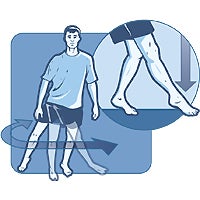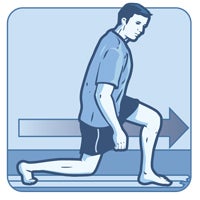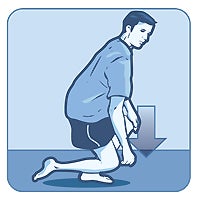Heading out the door? Read this article on the new Outside+ app available now on iOS devices for members! Download the app.
Balance never goes out of style. Tune yours up with this workout from Backpacker‘s archive.
In the backcountry, you don’t need to stick an Olympic-style landing after doing a vault, but you might need to cross a river on slippery rocks while wearing a pack. And for that you need good balance. The best gymnasts learn to “think through their feet,” says John Blievernicht, a sports physiologist who’s worked with Olympic athletes. Backpackers, he says, depend too much on their boots for stability: “Ideally, you strengthen your feet first, and then use your shoes for secondary support.” To improve your rough-trail confidence, remove your shoes and socks and practice exercises to improve your balance.

Hip Flexor Balance
How Stand on uneven ground or a foam cushion. Cock one leg to the side while remaining upright. Gradually shift that leg in front of you, across to the opposite side, and finally behind you. As your balance improves, increase the difficulty by standing on the ball of your foot and closing your eyes.
Why This simple, effective maneuver builds lateral hip strength. Doing it with your eyes closed makes your muscles rely on your body’s other physical senses. “Most balance ability comes from mental concentration,” says Liang Chow, coach of Shawn Johnson, the 2007 World Gymnastics Champion.

Balance-Beam Lunges
How Lay a 10-foot-long 2-by-4 on the ground, wide-side up, or place two strips of masking tape on the floor to mimic a 10-foot beam. Start at one end, and lunge forward slowly with one foot until your front and back legs bend at 90-degree angles. Continue with the other leg and repeat. Do 10 lunges total.
Why Staying on a beam forces you to balance laterally while moving forward, and it’s good preparation for crossing a slippery log or a navigating a narrow ledge. “You learn not to use your upper body,” says Blievernicht, “and to move smoothly and efficiently.”

Single-Leg Squats
How Stand on a mat with one leg raised, keeping it relaxed with the knee bent. Lower yourself until your unweighted knee nears the floor, and then slowly return. Start with two sets of five for each leg.
Why In one exercise you strengthen large muscles like quads and glutes, and improve the balancing ability of your ankles and calves. The lower you go, the more difficult it is to stay stable. One tip: Don’t look down at your feet, suggests Dr. William Sands, a sports scientist at the U.S. Olympic Training Center. Instead, focus on an eye-level object 10 feet in front of you.